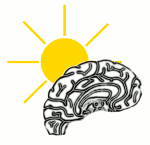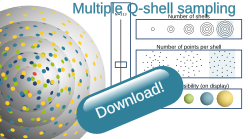OpenMEEG

OpenMEEGis a C++ open source implementation of the symmetric BEM approach as well as several tools allowing to solve the MEG/EEG forward and inverse problems. The 1.0 version of OpenMEEG has been released in 2008. With the intent of making OpenMEEG available to a widespread community, much work has been done to provide handy user interfaces for OpenMEEG via Python wrappers, interfacing with the FieldTrip Matlab toolbox for MEG/EEG analysis. Users of OpenMEEG today include: Montpellier LIRMM Laboratory, University of Montreal, University of Bourgogne, Donders Institute for Brain, Cognition and Behaviour, the Laboratoire de Neurobiologie de la Cognition, Université de Provence, University of Genoa, University of Texas Health Science Center, University of Konstanz
- Software Home Page
- OpenMEEG
ImplicitMesh
The software ImplicitMesh implements our ideas on FEM based MEG/EEG forward problem. The software is not yet public but this is planned for the near future. The three main advantages of this software are:
- it can handle some anisotropy in the conductivities,
- it is simpler to use than the few other available FEM implementations for the MEG/EEG forward problem as it uses directly implicit representations of the head instead of tetraedral meshes
- due to this compact representation and to the properties of FEM, it can handle very accurate geometries of the head at a moderate cost.
Q-Space sampling protocol

We have developed several algorithms for the optimal design of sampling scheme in diffusion MRI, including single and multiple Q-shell configurations. All the point sets configurations are available through a Web Application, from which you can select acquisition parameters (number of points, number of shells, etc.), generate corresponding scheme and download it as a text file for your experiments and acquisitions.
-
Talon
Talon is a pure Python package that implements Tractograms As Linear Operators in Neuroimaging. The software provides the talon Python module, which includes all the functions and tools that are necessary for filtering a tractogram. In particular, specific functions are devoted to 1) transforming a tractogram into a linear operator; 2) solving the inverse problem associated to the filtering of a tractogram and 3) use GPUs to speed up these operations.
Dmipy
The Dmipy software package facilitates the reproducible estimation of diffusion MRI-based microstructure features. It does this by taking a completely modular approach to Microstructure Imaging. Using Dmipy you can design, fit, and recover the parameters of any multi-compartment microstructure model in usually less than 10 lines of code. Created models can be used to simulate and fit data for any PGSE-based dMRI acquisition, including single shell, multi-shell, multi-diffusion time and multi-TE acquisition schemes.
WL-Align
WL-align is a pure Python package that implements the graph-alignment routine based on the generalization of the Weisfeiler-Lehman algorithm proposed in our paper (link: https://doi.org/10.1162/netn_a_00199). The software provides the wlalign Python module, which includes all the functions and tools that are necessary for computing network alignments and similarity. In particular, specific functions are devoted to 1) computing the graph Jaccard index of similarity between two weighted graphs and 2) solving the graph alignment problem with WL-align.
Diffusion MRI
The algorithms related to the Diffusion Tensor and Q-Ball imaging are all available upon request from the INRIA source forge https://gforge.inria.fr as an extension to the Brainvisa http://brainvisa.info software platform for visualization and analysis of multi-modality brain data. One can use all the estimation and visualization tools developed at Odyssée, from DTI estimation, regularization, segmentation to Q-Ball estimation, to fiber ODF estimation and tractography algorithms. We now have users from IRISA, VisAGseS, Rennes (Barillot et al), from INSERM, Paris and Université de Montreal (H. Benali, J.C. Cohen-Adad et al), from Salpêtrière Hospital, Paris (S.Lehericy, C.Delmaire, et al), from Toulouse (Landreau et al), from Eindhoven Technical University, CalTech in USA and other national and international sites. The current library includes geometric and variational methods developed to estimate, regularize, segment and perform tractography in DT (Diffusion Tensor) and HARDI (High Angular Resolution) MRI images. The library was embedded into two open-source high level languages languages, TCL and Python. Within this library, new visualization schemes for Q-Ball images represented by spherical harmonic decomposition were developed. These visualization schemes based on open-source software tools, the Visualization Toolkit (VTK) and the CImg library, greatly improve the speed and Application Programming Interface (API) usability of the visualization library. This work allowed integration with the interactive medical imaging platforms MedINRIA and 3D Slicer QBallSlicer.
The White Matter Query Language
The White Matter Query Language (WMQL), developed and maintained by Demian Wassermann, is a technique to formally describe white matter tracts and to automatically extract them from diffusion MRI volumes. This query language allows us to construct a dictionary of anatomical definitions describing white matter tracts. The definitions include adjacent gray and white matter regions, and rules for spatial relations. This enables the encoding of anatomical knowledge of the human brain white matter as well as the automated coherent labeling of white matter anatomy across subjects.
This is an implementation of the WMQL language presented in "On Describing HumanWhite Matter Anatomy: The White Matter Query Language"
FindSources3D
It is dedicated to the resolution of inverse problems of source detection and localization from pointwise measurements of the electric potential on the spherical boundary of a domain made of spherical layers with constant conductivities. It allows to approximately locate pointwise dipolar sources, in the brain (modelled as a ball) from EEG (electroencephalography)measurements taken by electrodes on the scalp, or from numerical data.It uses the RARL2 software developped by APICS for the rational approximation step in plane sections. The data transmission preliminary step (“cortical mapping”) is solved using the OpenMEEG symmetric BEM (see above). FindSources3D was developped in Matlab within the APICS team-project, in joint collaboration with Odyssée/Athena and Ecole des Mines.
EMBAL
Electro-Magnetic Brain Activity Localization), initiated by Alexandre Gramfort during his PhD, is a Matlab library for solving the inverse problem involved in neuronal source localization using MEG and EEG. It includes MUSIC source localization, distributed inverse problems with L1, L2, Total Variation, spatio-temporal, and graph-cut based optimization.

